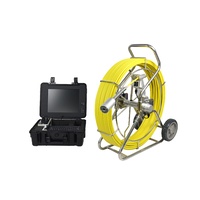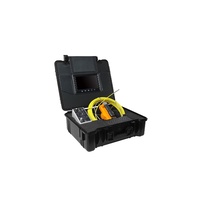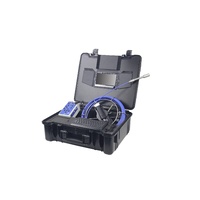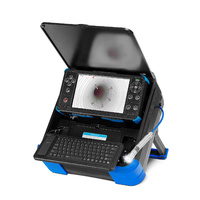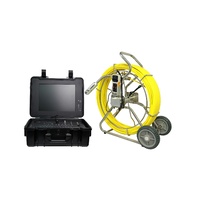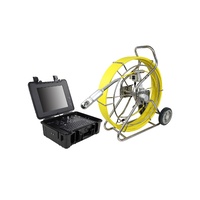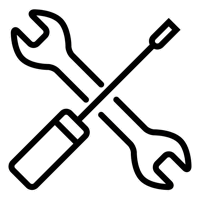The TX-200 Borehole & Shaft Inspection Camera System gives engineers, drillers and contractors dependable underground visibility without excavation. Its high-clarity camera head, powerful LED illumination and on-screen depth indication help teams locate, document and communicate subsurface conditions in boreholes, wells, vertical shafts and drilled foundations with confidence.
Built for harsh field use, the TX-200 combines a portable control unit with a field-ready reel and rugged cable, so operators can deploy fast, capture clear video and stills, and leave site with report-ready evidence. For routine well checks or urgent troubleshooting, the TX-200 delivers a dependable, repeatable workflow that saves time and reduces risk.
Key Features
- High-clarity camera imaging to reveal defects, mineral deposits and wall conditions in tight underground spaces.
- Adjustable LED illumination for even lighting and consistent imaging in dark or turbid environments.
- On-screen depth indication to log exact locations of findings and speed corrective actions.
- Durable, abrasion-resistant cable designed for repeated deployment in rough boreholes.
- Portable control unit & reel for quick setup, transport and on-site productivity.
- Video & photo capture supporting evidence-based reporting and client communication.
- Simple, intuitive interface that shortens onboarding and reduces operator error.
Technical Design & Build
The TX-200’s optics and lighting are tuned for underground inspection. A balanced LED array provides uniform illumination to minimise hotspots and shadows, while the optics deliver clean, low-distortion visuals of the well or shaft wall. The camera head is sealed for submerged use, and the assembly is engineered to tolerate repeated thermal and mechanical stress during field operations.
The reel and cable system emphasise control and protection. Smooth pay-out and retrieval reduce snagging risk and protect the camera when working past irregularities or casing joints. The abrasion-resistant jacket and flexible construction support longevity under frequent use. The control unit focuses on usability: quick boot, intuitive controls, on-screen depth readout and one-touch recording for video and stills. Files can be exported in common formats for archiving, analysis and stakeholder reports.
Applications
- Water wells — casing checks, blockage detection, pump intake review and repair verification.
- Geotechnical drilling — stratigraphy visuals, formation transitions and stability observations.
- Mining shafts — wall condition, water ingress, void identification and post-blast checks.
- Civil & foundations — drilled shafts, piles, caissons and anchor bores for structural assurance.
- Environmental & hydrogeology — aquifer layers, screen positions and contamination screening.
- Research & education — repeatable visuals for training, studies and publications.
Benefits & ROI
- Cut investigation costs by seeing underground before drilling further or excavating.
- Reduce downtime with rapid deployment and decisive data capture.
- Improve safety & compliance using clear visual evidence in reports and audits.
- Win more work by delivering professional video documentation to clients.
- Enhance decision quality with depth-referenced observations that are easy to revisit and share.
Field Workflow
- Setup — position the reel, connect the control unit and verify camera/lighting operation.
- Deploy — lower the camera steadily, adjusting LED brightness for clarity.
- Observe — monitor the feed, use on-screen depth to tag significant features.
- Document — capture video and stills for each finding; narrate where useful.
- Retrieve & Report — export files, attach to inspection reports and plan remediation.
TX-200 vs Alternatives
Entry-level consumer cameras aren’t built for deep shafts, repeated deployment or precise documentation. The TX-200 is designed for professionals who need consistent clarity, depth-referenced evidence and field durability at a practical price point. If your workload demands deeper inspections (up to 500m), consider the TX-300.
TX-200 FAQs
How deep can I inspect with the TX-200?
The standard depth is 100m, but it can be extended up to 300m. The platform is designed for typical borehole, well and shaft inspections in water, mining and civil work.
Does it record video and photos?
Yes — the control unit captures video and still images for documentation and reporting using common file formats.
Is training required?
Basic operation is intuitive; most teams are productive with minimal onboarding. Best-practice guides are available on request.
Is the camera head waterproof?
The camera head is sealed for submerged use in water-filled wells and shafts. Waterproof rating is to a depth of 2,000m.
Get Pricing & Availability
Contact Testrix Systems for a tailored quote, lead time and cable configuration advice for your inspection depths and shaft geometry.








